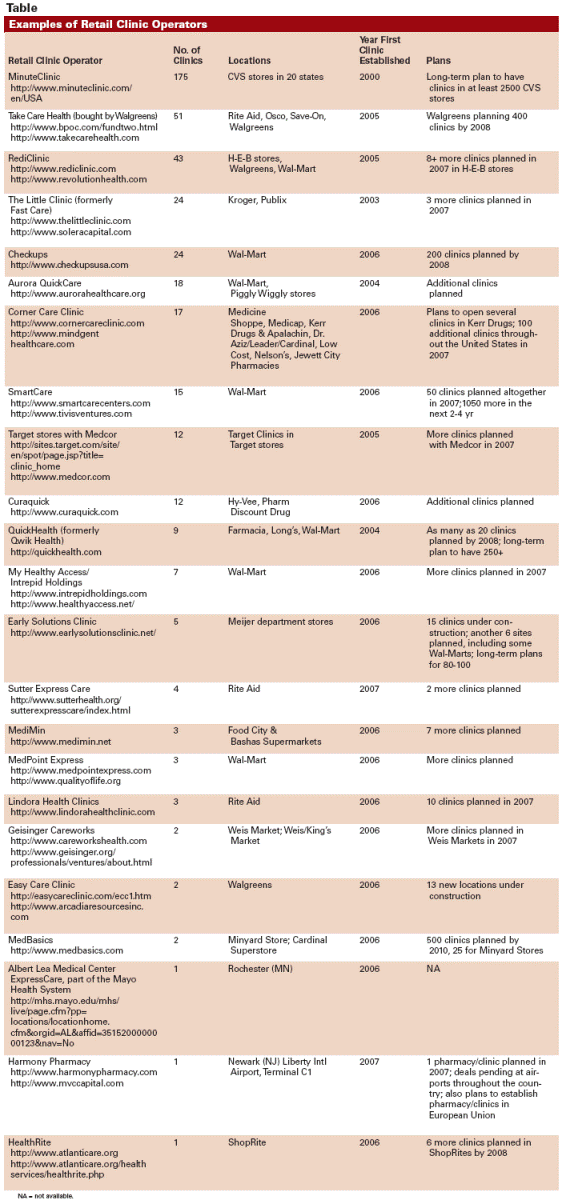Primary Care Clinics Take Root in Retail Pharmacies
With increasing fanfare, pharmacies, supermarkets, and ?big-box? retailers are leasing space in their stores to health clinics in the hopes of attracting new customers and driving up sales revenues. Today there are ~500 retail clinics in the United States. At the World Health Congress in April 2007, Wal-Mart announced its plans to host as many as 2000 clinics in its stores in the next 5 to 7 years, firmly rooting this new brand of retail medicine in communities around the country. Wal-Mart presently hosts ~76 retail clinics.
With this influx of retail clinics, pharmacists could proactively team with clinic staff members to routinely share general information on patient demands and trends on conditions that are common to the individual communities their pharmacies serve. To date, however, any teaming between clinic and pharmacy staffs has been largely informal. Instead, the pressure is on the clinics to puzzle out their business models and reach profitability in the face of many challenges. More than 20 companies run these new clinics, and most are privately held. Notable exceptions include CVS/MinuteClinic, Target Clinics, Intrepid/My Healthy Access, and hospital-funded retail clinics. CVS/ MinuteClinic and RediClinic are among the leading clinic operators, and Walgreens has just bought Take Care Health.
As tenants of the retail stores in which they operate, retail clinics are responsible for their own success. With relatively high fixed costs, it is difficult for clinics to break even, according to such analysts as Mary Kay Scott, author of ?Health Care in the Express Lane: The Emergence of Retail Clinics,? a report published by the California HealthCare Foundation in July 2006.
For example, retail clinic operator My Healthy Access has a 36-month master rental agreement with Wal-Mart for ~$1620 per month for each clinic, or ~$20,000 per year per clinic, according to the most recent 10K filing from its parent company, Intrepid Holdings. Labor (~$75,000 salary plus benefits for each nurse practitioner [NP]), information technology, malpractice insurance, rent, and corporate overhead are 85% of fixed costs. Variable expenses, laboratory tests, and equipment make up ~15%.
A 450-sq-ft clinic with fixed costs of $600,000, just to break even, would need to see 2 to 3 patients per hour, 30 per day, 220 per week, and 11,500 per year, according to Scott?s report. This calculation assumes that each patient visit averages $52?with a range of $40 to $100. If a clinic is able to sustain that patient load, it is still too soon to know to what extent patients will pay out of pocket or file insurance claims. Processing insurance claims for a high volume of patients also could be a considerable operating cost.
Clinic Demand
In spite of the uncertainties and financial challenges in this nascent market, positive consumer response to recent surveys and the shortage of family physicians have encouraged clinic operators and their investors to keep expanding. Retailers?and increasingly drugstore chains?are banking on 1-stop shopping to attract more customers and to drive up in-store sales on such items as prescription drugs and OTC medications. Clinic operators pitch retailers when trying to secure lease agreements, citing how much more revenue they will drive.
For example, 95% of patients diagnosed in Target clinics in a 2006 survey had their prescriptions filled in the same store. This survey was conducted before Target established its own clinics and leased space to operators such as MinuteClinic, prior to that firm?s acquisition by CVS.
Clinic operators hosted by retailers are capitalizing on consumer frustration with established primary care physicians. Part of the market-scoping process is to get data on local emergency department traffic and the ratio of family physicians to the metropolitan population.
There is a natural rift between established family practices and clinics, adding to clinic operators? challenges. At the same time, as a new access point, clinics potentially create opportunities for pharmacists to team with clinic staff in providing patient care.
Family Physician/Clinic Operator Rifts
The threat of competition is arguably physicians? strongest concern. Pediatricians and general practitioners also are worried about continuity of care and quality standards.
NPs and physician assistants (PAs) treat patients at most retail clinics. They follow state regulations that determine their scope of practice and when they need to check in with a physician before making a treatment decision, for example. In an effort to satisfy demands from physician associations, the Convenient Care Association members have agreed to follow guidelines for managing their retail clinic staff and operations.
Yet, state chapters of physician associations still are lobbying for laws that would stiffen existing regulations for the medical staff that run clinics. Stricter state regulations could increase the cost of running retail clinics, potentially cutting into margins and slowing clinic operators? ability to reach or maintain profitability.
At press time, the Massachusetts State Board of Health was evaluating CVS/MinuteClinic?s request to set up retail clinics. In May, the Illinois State Medical Society introduced the Retail Health Care Facility Permit Act that would limit doctors to supervising 2 ?advance practice? nurses and would limit the scope of retail clinic advertising.
High Marks from Consumers
In the face of potentially costly regulations, recent consumer surveys have encouraged retail clinic operators and their retail hosts to keep expanding. Although few consumers actually have been treated at retail clinics, those who have have had positive experiences, according to a Wall Street Journal Online/Harris Interactive poll of >2000 consumers. Ninety percent of those surveyed said that they were satisfied with the quality of care.
A related survey conducted by CS Mott Children?s Hospital at the University of Michigan found that parents would gladly trust NPs and PAs to treat their children in retail clinics. Among parents who had previously taken their child to a retail clinic for care, >70% planned to return.
A Market Strategies Inc study also found that 30% of consumers surveyed think that retail clinics should compete with primary care physicians by offering a broader variety of more complex care and diagnostic services.
Medication Therapy Management (MTM)
These survey data could be used to develop more organized ways for pharmacists and clinic staff members to team up on patient care. Recent MTM pharmacist training tours could potentially complement care provided in retail clinics.
For example, Rite Aid?s MTM program, Rite Care, is partnering with doctors and the University of Pittsburgh to treat patients with chronic conditions. This service for a fee needs to be marketed to patients as well as to payers. In a recently filed 10K, Rite Aid reported that it is ready to gear up and go national with MTM services in its pharmacies, should demand increase and payers provide reimbursement.
?The key to the whole puzzle is developing a system to pay pharmacists for these services. As long as the pharmacy reimbursement model is based only on product distribution, it is very hard to see how this type of model could be viable in a retail pharmacy setting,? said John Cronin, owner of community pharmacies in southern California and a lawyer who focuses on pharmacy law.
Emerging Business Models, Still Unproven
The known brands such as Wal-Mart and Walgreens tend to get the spotlight, but Wal-Mart does not own or operate any of the clinics in its stores. In spite of the obvious cross-marketing opportunities, particularly for pharmacies, most clinic operators are not tied in any substantive way to the retailers from which they lease space, with notable exceptions such as Target Clinics and CVS/MinuteClinics.
Although in-store clinics have been operating since 2000, only in the past year or so have clinic operators announced plans to expand aggressively. Retailers and clinics are both experimenting with various business models and ways of leveraging the others? resources. Smaller players have established unique identities in the regions in which they operate.
For example, Harmony Pharmacy has established a pharmacy/retail clinic at Newark Liberty International Airport in New Jersey, focusing on travelers and airport employees. My Health Access is targeting the uninsured and underinsured in urban communities. QuickCare and MediMin offer translation services to Hispanic communities and also target the uninsured and underinsured.
Even if a business model proves sustainable, clinic operators face staffing bottlenecks. Thousands of clinics are planned in the coming 3 to 5 years, but the NPs and PAs required to staff them are in short supply. If these tenant/clinics are not prepared to staff up and offer quality of care consistently, the reputation?and the sales revenue?of the host retailers could suffer. As a result, retailers are starting to carefully evaluate which clinic operators to host and which would be the most reliable partners.
Ms. Christopher is a freelance writer based in Portland, Ore.


